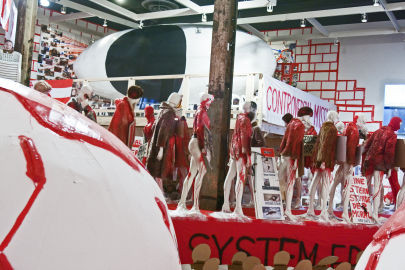Thomas Hirschhorn
11 Mar - 29 May 2011

© Thomas Hirschhorn
Das Auge (The Eye), 2008
Mixed media
Installation view: The Power Plant, Toronto. Courtesy the artist. Photo: Steve Payne.
Das Auge (The Eye), 2008
Mixed media
Installation view: The Power Plant, Toronto. Courtesy the artist. Photo: Steve Payne.
THOMAS HIRSCHHORN
Das Auge (The Eye)
11 March - 29 May, 2011
The North American premiere of one of Thomas Hirschhorn’s largest and most immersive works.
Das Auge (The Eye) is one of Thomas Hirschhorn’s largest and most visceral sculptural installations yet to be presented. Selected to represent his native Switzerland at the 2011 Venice Biennale, Hirschhorn is renowned for his sprawling, immersive artworks that use everyday materials, found images from the news and mass media, and impassioned graffiti-like texts to engage audiences in actively thinking about politics and philosophy. Hirschhorn is interested in the aesthetics of political protest – slogans, placards, provocative photos – and in moving people to think and act critically in the world.
Sprawling over the gallery’s largest space as well as a specially constructed mezzanine, the ambitious Das Auge (The Eye) was first presented at the Vienna Secession in 2008. Crafted out of paper, packing tape, colour photocopies, stuffed animals, mannequins, and other provisional materials, the exhibition is based around the image of an eye that sees only the colour red. Cobbled together from hundreds of different sculptural elements, images and texts, the entire mise-en-scène is dominated by the juxtaposition of red and white: the flags of Canada, Switzerland and other nations; the veins in an eye; blood on snow. The artist has written: “Das Auge [The Eye] does not see everything – but it sees everything that is red. Das Auge only sees the colour red. Thus it can only show red, it can only name red, and it can only ‘be’ red.” Potent and overwhelming, Das Auge (The Eye) links perception and voyeurism with the politics of the body, all-seeing eye to all-too-fragile flesh.
Thomas Hirschhorn (born in 1957, Bern, Switzerland) lives and works in Paris. Since the 1980s, the former graphic designer has evolved a radical sculptural installation practice.
Recent solo exhibitions have taken place at the Palais de Tokyo, Paris (2004), Institute of Contemporary Art, Boston (2005), Pinakothek der Moderne, Munich (2005), Museo de Arte Contemporaneo de Castilla y Leon, Spain (2006), Musée d’art contemporain de Montréal (2007), and Museo Tamayo, Mexico (2008). He was included in documenta 11, Kassel (2002), 27th São Paolo Biennale (2006), and the 55th Carnegie International, Pittsburgh (2008). Hirschhorn has received the Marcel Duchamp Prize (2001) and the Joseph Beuys Prize (2004).
The exhibition is accompanied by a publication featuring an interview between Thomas Hirschhorn and Gregory Burke (Director of The Power Plant and organizer of the exhibition), a statement by the artist and full-colour images of Das Auge (The Eye).
Das Auge (The Eye)
11 March - 29 May, 2011
The North American premiere of one of Thomas Hirschhorn’s largest and most immersive works.
Das Auge (The Eye) is one of Thomas Hirschhorn’s largest and most visceral sculptural installations yet to be presented. Selected to represent his native Switzerland at the 2011 Venice Biennale, Hirschhorn is renowned for his sprawling, immersive artworks that use everyday materials, found images from the news and mass media, and impassioned graffiti-like texts to engage audiences in actively thinking about politics and philosophy. Hirschhorn is interested in the aesthetics of political protest – slogans, placards, provocative photos – and in moving people to think and act critically in the world.
Sprawling over the gallery’s largest space as well as a specially constructed mezzanine, the ambitious Das Auge (The Eye) was first presented at the Vienna Secession in 2008. Crafted out of paper, packing tape, colour photocopies, stuffed animals, mannequins, and other provisional materials, the exhibition is based around the image of an eye that sees only the colour red. Cobbled together from hundreds of different sculptural elements, images and texts, the entire mise-en-scène is dominated by the juxtaposition of red and white: the flags of Canada, Switzerland and other nations; the veins in an eye; blood on snow. The artist has written: “Das Auge [The Eye] does not see everything – but it sees everything that is red. Das Auge only sees the colour red. Thus it can only show red, it can only name red, and it can only ‘be’ red.” Potent and overwhelming, Das Auge (The Eye) links perception and voyeurism with the politics of the body, all-seeing eye to all-too-fragile flesh.
Thomas Hirschhorn (born in 1957, Bern, Switzerland) lives and works in Paris. Since the 1980s, the former graphic designer has evolved a radical sculptural installation practice.
Recent solo exhibitions have taken place at the Palais de Tokyo, Paris (2004), Institute of Contemporary Art, Boston (2005), Pinakothek der Moderne, Munich (2005), Museo de Arte Contemporaneo de Castilla y Leon, Spain (2006), Musée d’art contemporain de Montréal (2007), and Museo Tamayo, Mexico (2008). He was included in documenta 11, Kassel (2002), 27th São Paolo Biennale (2006), and the 55th Carnegie International, Pittsburgh (2008). Hirschhorn has received the Marcel Duchamp Prize (2001) and the Joseph Beuys Prize (2004).
The exhibition is accompanied by a publication featuring an interview between Thomas Hirschhorn and Gregory Burke (Director of The Power Plant and organizer of the exhibition), a statement by the artist and full-colour images of Das Auge (The Eye).
